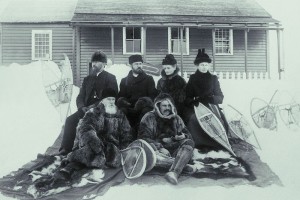Winter Walkabout: Try a Snowshoe Adventure
Science and Nature for a Pie is on Facebook! Visit www.facebook.com/scienceandnatureforapie and click “follow” for photos, facts, and notices about new blog posts!
Though winter is here, plenty of animals are still active. And not just the ubiquitous squirrels or sparrows, either. Fox. Owls. Turkeys. They’re still around, hunting for food, making a living; just trying to survive. They prowl the night, or hunker under a bush for shelter and protection lest they become hunted. And, though they’re rarely seen, those animals and others are more visible than ever right now. They’re there. If you’re not afraid to go out and look. But how to get there when there’s two feet of snow on the ground? Snowshoeing may be just the answer, and Audubon can help with the learning.
“There’s a saying in snow shoeing: if you can walk, you can snowshoe.” Scott Ruhren, Senior Director of Conservation for the Audubon Society of Rhode Island (ASRI), describes the simplicity involved in strapping on the footwear that has been around for hundreds of years. Saturday, February 7, Ruhren will lead a group around Caratunk Wildlife Refuge to learn the technique and shake off the cabin fever. (Space is still available; check www.asri.org for more information.)
“One of the benefits of going out on snowshoes is that you can sneak up on wildlife,” Ruhren says. “It’s very quiet, since all the people are at home.” In addition, the animals are more visible. This is not because there are more of them, but rather, their signs are easier to locate. “When there’s the right type of snow on the ground, it shows evidence that the animals are around. They leave tracks.” Animals like fox do not hibernate in winter, and it is possible to discover their prints. “Fox hearing is so acute that they can hear mice moving under the snow,” according to Ruhren. “They listen, and then dive headfirst into the snow to grab them.” (Check YouTube for videos of this fascinating behavior.) Distinguishing fox tracks from that of a dog is based on its behavior. “Fox run with a purpose. They move in a nice straight line, where dogs tend to meander.” New England is home to both gray and red fox, according to Ruhren, and seeing evidence of them is all the more reason to try the sport.
In addition to obtaining a unique view of nature, strapping on a set of snow shoes has numerous other benefits. Unlike snowboarding or skiing, it’s a sport with little or no risk of injury, since there’s no hurtling down a hill. It does provide a good aerobic workout – if you want it to. Pacing is up to the individual, so you can push to cover territory and work up a sweat, burning off those winter fatty foods that we’re supposedly drawn to. Or, you can take a leisurely stroll and listen to the sounds of the wind in the trees.
Taking up snow shoeing is easy on the savings account, too. There are no lift passes to buy, and the equipment itself is less costly than other snow sports. A quick look at a well-known outdoor outfitter’s site reveals that they’re in the $100 – $300 range. Packages, which include the snow shoes, poles (optional but helpful), and a bag, are also available and are a good bet for beginners. But perhaps the best choice is rental. Local outfitters like REI and Eastern Mountain Sports have snow shoes available for around $20 per day, allowing you to try on different styles and see how you like the sport. Sizing is based on the sex and weight of the individual, with longer shoes needed to distribute the weight of a larger person evenly.
Once the snowshoes are taken care of, there are a few other things to consider. Ruhren strongly suggests dressing in layers. “It doesn’t take long to work up a sweat when you’re on snow shoes. You want to be able to remove some of the clothing you have on. Another thing is to try and dress in layers that wick moisture away from your skin.” While these recommendations may be less critical for local, flat terrain where the hiker may be out for shorter durations, proper dress will still result in a more comfortable adventure.
Another must is water. “A lot of people don’t realize how important it is to keep hydrated in winter,” Ruhren says. “They may not feel the moisture loss because of the temperatures, but you really need to make sure you’re replacing fluids.”
Keep in mind, too, that a snow covered lake may look a tempting place for a snow shoe stroll, but the result of giving in to that temptation could be disastrous. Always check with officials to be certain the ice is safe, even when the temperatures that day are low. Plus, as with any park, remember that having snowshoes is not an invitation to stray from marked trails.
Scott Ruhren says the ASRI event will cater to all levels of stamina and expertise. “We can tailor the activity to the people who show up. The terrain is flat to rolling, so it’s a great place to begin learning.”








